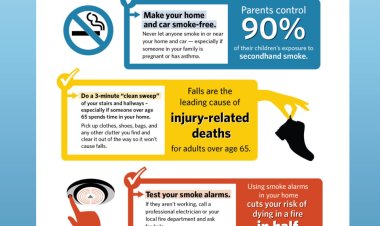10 Tips to Keep Your Family Healthy While at Home

Parents and kids alike are finding themselves navigating new routines at home while businesses and schools are closed because of the COVID-19 pandemic. For many, it can be tough to balance work and family life when they overlap at home.
That’s why it’s more important than ever to prioritize your family’s physical, mental, and emotional health. All of the change can feel overwhelming, but keeping your family healthy doesn’t have to be.
How to keep your family healthy while social distancing.
Try these ten tips to keep your family healthy while you’re at home.
1. Stay active together and get outside.
It’s important for both adults and kids to get moving throughout the day, especially as we’re spending more sedentary time working from home or participating in distance learning. Staying active is great for our physical health, and it can also help fight stress and anxiety that may arise as your family deals with a loss of daily normalcy.
Kids should move for at least one hour each day in an activity that increases their heart rate. While your family is limited in the places you can go to exercise, there are a variety of activities your family can do together at home, like a virtual fitness class or an impromptu family dance competition. As long as you maintain six feet from others, it’s safe to take your family outdoors for exercise, such as going for a walk or a bike ride.
2. Drink enough water.
Staying hydrated is important for your body to function properly. Water also has a significant impact on your energy levels, brain function, and general health. With everything that’s going on, it can be hard to remember to drink enough water, but try these creative ways to get your kids to increase their water intake:
- Use a silly straw
- Freeze water into fun shapes and add it to their drinks
- Incorporate more fruits and vegetables into your diet
- Flavor water with pieces of fruit or a splash of juice
You can also teach your kids to monitor their water intake by checking the color of their urine. If it’s a pale yellow or clear, they’re doing great. If it’s dark, they should drink more water.
3. Avoid too much caffeine.
Too much of anything can be a bad thing, and that includes drinking too much coffee, tea, or soda. Caffeine can increase your heart rate and blood pressure, which may negatively affect your health. Since we don’t know how long we’ll be quarantined, try to avoid drinking an extra cup of coffee, as it will be harder to eliminate as things return to normal.
4. Encourage everyone to eat a well-balanced diet.
You may not be taking as many trips to the grocery store while social distancing, so it can be harder to make healthy food choices. Do the best you can. If you have room in your freezer, take advantage of frozen fruits and veggies, which are picked at the same time as fresh produce and then “flash frozen” to store nutrients. They offer the same nutritional value, but will last longer.
It can be tempting to snack more while you’re working at home, but try to maintain a normal eating schedule of three balanced meals each day. You can certainly give in to a craving here and there, but again, you want to make choices that will be sustainable since we don’t know when we can resume our regular routines. On the other hand, it’s not uncommon for kids to eat much less at mealtimes, so don’t be afraid to offer them healthy snacks throughout the day.
5. Take time to build community.
In today’s digital era, it's harder than ever to focus on your family because of constant distractions from social media and technology. On top of that, many extended families are geographically dispersed, making it challenging to have “a village” around to help. Leverage technology and host virtual family gatherings with extended family.
Social isolation is stressful. That’s why now is a great time to strengthen your family unit by being intentional with your time together. One of the best ways to do this is to share meals together.
Aside from your immediate family staying connected, you can also join in on virtual gatherings hosted by local or national organizations. Many zoos, parks, museums, and churches are using video feeds to provide entertainment, connect over shared interests, and maintain cultural and religious traditions.
6. Follow a bedtime routine and get enough sleep.
Checking how you feel in the morning is one of the best ways to determine if you’re sleeping enough. Do you feel tired or refreshed? Getting enough sleep is important to having enough energy and being able to concentrate throughout the day. If you or your kids are struggling, try to go to bed earlier. A regular bedtime routine can help you fall asleep more easily because your body knows what’s coming.
Bedtime can also be a great time to connect with your kids emotionally, as they may be processing the day. That’s why now is a great time to...
7. Talk about your feelings.
Many people are feeling more anxiety than usual with all of the uncertainty and change. It’s okay to experience worry, grief, anger, or any variety of emotions. Encourage your kids to talk about how they’re feeling, and acknowledge that anything they’re feeling is normal and valid.
8. Limit screen time as much as possible.
It’s important to know what’s going on in the world, but too much time on social media or watching tv can increase stress and anxiety. While your kids may need to use technology more than usual for distance learning, incorporating other activities in small blocks of time in between screen time can help to break it up.
9. Practice preventative medicine, like regular handwashing.
Hand hygiene is always one of the best ways to minimize the spread of germs and prevent illness. You can reduce the risk of illness by practicing other preventive medicine guidelines, such as:
- Coughing or sneezing into your sleeve
- Disinfecting frequently touched surfaces in your home
- Staying up-to-date on regular screenings and immunizations
10. Partner with your primary care provider using video visits or other forms of virtual communication.
Information changes rapidly and it can be hard to sort through fact and fiction. Your primary care provider (PCP) is your best source of accurate information and they’re here to answer any questions or alleviate any concerns you may have.
Use technology to connect with your doctor about the best place or time to seek care. Many physician offices are communicating virtually through different services, such as MedStar Health’s Video Visits, which connect patients to medical professionals via smartphone, tablet, or computer. Find a primary care provider near you or call your current PCP to find out the best way to stay in touch.
If you or someone in your family has shortness of breath, persistent cough, or worsening fever, contact your doctor immediately.
Get the care you need, now.
It’s important that you don’t delay your medical needs or ignore symptoms that would typically make you seek care. Early detection and treatment improve our ability to provide the most comprehensive and effective care.
Since the COVID-19 pandemic reached our region, MedStar Health has made innovations to ensure we are still the best and safest place to receive care.
We have worked hard to make sure we can provide the care you need in the most appropriate and safe setting. MedStar Health Video Visits are still options for a variety of appointment needs, but in some cases, an in-person visit may be best. We’re here to help you get the right care that reflects your needs and comfort level.
We’re open and prepared to safely offer the same high-quality care you expect from MedStar Health, when you are ready to see us.






/__opt__aboutcom__coeus__resources__content_migration__serious_eats__seriouseats.com__images__2015__05__20150511-scrambled-eggs-vicky-wasik-11-21d8f74e84524493a335065a7558b532.jpg)



